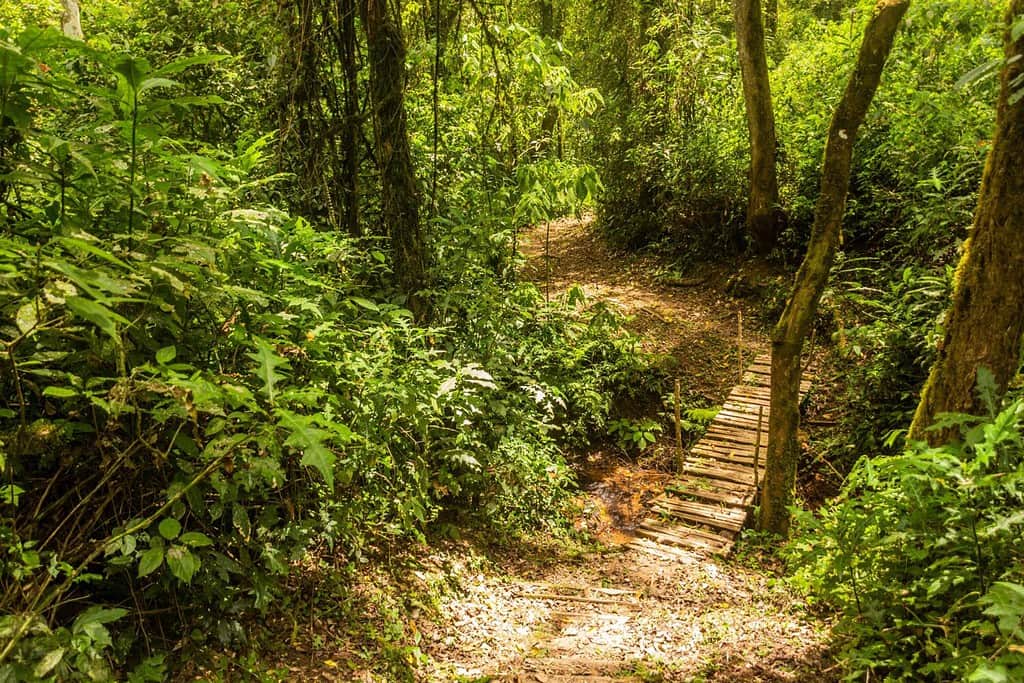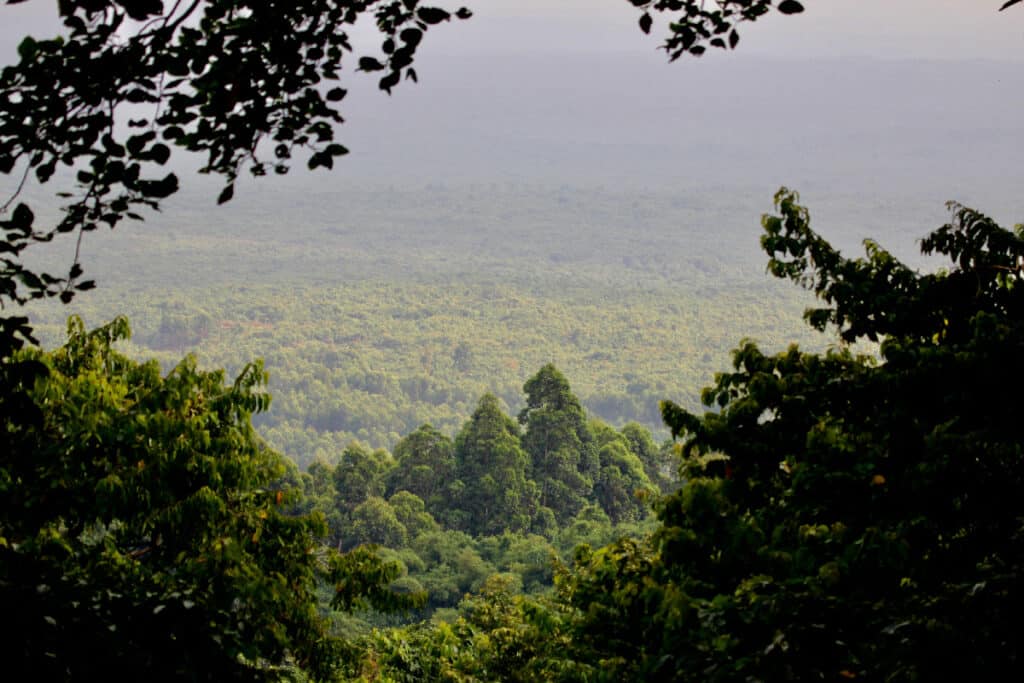Much of the continent of Africa does not feature forested areas. Most of the remaining rainforests in Africa sit in the Congo River basin. Due to threats from logging, agriculture, and hunting, forests continue to shrink. Taking all the forests of Africa into account, very few of them can be counted among the ancient, primeval forests that spread across the world long before human presence. Only 8% of the old-growth forests on earth today can be found on the continent of Africa. However, you can find excellent examples of flora and fauna where there are still old-growth forests. Discover where you can explore the oldest forests in Africa.
1. Kakamega Forest

Once one of the most extensive old-growth forests in the world, exploitative practices have decimated Kakamega Forest in the last 40 years.
©Matyas Rehak/Shutterstock.com
Kakamega Forest, a tropical rainforest just northwest of the capital city of Nairobi, is the last piece of Guineo-Congolian rainforest left in Kenya. Once, this incredible forest feature spread across much more of the African continent. This forest, the last of its type in Kenya, is about 22 miles from Lake Victoria.
Being a tropical rainforest, Kakamega experiences a lot of rainfall every year, at least 1200 mm. Around 380 species of ferns, trees, and flowering plants call Kakamega Forest home. The birds of Kakamega are perhaps its most famous feature, with nine species that cannot be found anywhere else in the world. Great blue turacos and horned grey-cheeked hornbills take over 400 butterfly species to the skies in the forest. Scientists have seen rare tree pangolins in the forest, too.
Logging and agricultural expansion have led to the decline of large portions of Kakamega Forest. Only about 92 square miles of forest remains, including two protected areas. In 1933, a forest reserve designation provided minimal protection. In 1985, the Kenya government added more protection with a national reserve. The African cherry tree and ginger vine traditionally serve medicinal purposes in different indigenous cultures and still grow in the forest despite overharvesting.
2. Nyungwe Forest

Tourism offers a gateway into the history of Nyungwe Forest. Visitors can learn more about three
chimpanzee
communities tracked in the park.
©Tetyana Dotsenko/Shutterstock.com
The largest forested area in Rwanda, Nyungwe Forest, is one of the oldest rainforests left standing in Africa. Nyungwe forms a watershed between the drainage systems of some of the world’s largest rivers, the Congo and the Nile. Humans have had a presence in this forest going back thousands of years.
A hotspot for biodiversity, Nyungwe Forest has a recorded 1,068 plant species, 322 bird species, and 75 mammal species. At least 13 primate species call this forest home, including golden monkeys, L’hoest monkeys, red-tailed monkeys, and chimpanzees.
In 2005, the Rwandan government elected to officially protect the forest as part of the Nyungwe National Park. The area covers 393 square miles of land, making it one of the largest national parks in Rwanda. One of the goals of the protection has been to reverse the negative impacts of exploitative practices. Efforts to stop illegal mining, poaching, and unsustainable agriculture have come together in partnership with community partners.
3. Congo Basin Rainforest

The most significant portion of the Congo Basin rainforest is in the Democratic Republic of Congo, a large Central African country.
©Kiki Dohmeier/Shutterstock.com
The second-largest rainforest in the world and one of Africa’s oldest forests, the Congo Basin rainforest also features some of the most giant trees in Africa. Sometimes referred to as the world’s second green lung, this rainforest holds around 8% of the carbon on the planet. Unfortunately, continued disruptions to the normal functions of the forest result in the release of some of this carbon into the atmosphere.
Incredibly biodiverse, the Congo Basin extends from Gabon to the Democratic Republic of Congo. This rainforest is famously home to African forest elephants, gorillas, and chimpanzees. Large trees like sipo (Entandrophragma utile) and moabi (Baillonella toxisperma) grow in the forest and have long served as vital resources for local peoples.
Various protected areas run through all six countries where the forest exists. About 10% of the forest has some form of protection, and UNESCO marks nine different World Heritage sites throughout the forest. However, deforestation is an ever-present issue and threat to the integrity of this forest, especially its oldest parts.
4. Tiwai Island

Tiwai means “Big Island” in the Mende language, spoken by over 1 million people in Sierra Leone.
Located in the southeastern part of Sierra Leone, the international community considers Tiwai Island a vital remnant of the ancient rainforests that once covered more of West Africa. One of the largest inland islands in Sierra Leone, this tropical island covers almost 3,000 acres of land. Together with the Gola Forest, Tiwai Island serves as part of the last remaining Upper Guinea tropical forest.
One of the unique features of Tiwai Island is that it is home to a large population of pygmy hippopotami, a notoriously hard-to-study animal. It is also famous for having one of the highest concentrations of primates in the world. 11 different species call the island home, including the endangered Diana monkey. Other rare species include white-breasted Guinea fowl and the Maxwell’s duiker, a small type of deer.
Today, the Environmental Foundation of Africa (EFA) protects the island as part of the Tiwai Island Wildlife Sanctuary. Founded in part to protect the integrity of the old-growth forest, the sanctuary operates research and outreach, too. Many of the surrounding farming communities have taken up roles as forest caretakers, including Koya and Barri Chiefdoms.
5. Réunion Island

The Mascarene bioregion, which Réunion Island is part of, hosts a diverse range of rainforests, lowland dry forests, swamp forests, and cloud forests.
©infografick/Shutterstock.com
Réunion Island, located off the coast of the larger island of Madagascar, is an overseas region administered by the country of France. It is part of the Mascarene Islands that are east of Madagascar. About 970 square miles in size, several important primary forests sit on the island, including Mare Longue Forest, Bélouve Forest, and Bébour Forest.
This island sits on a hotspot and was formed by two volcanoes, the Piton des Neiges and the active Piton de la Fournaise, and was uninhabited prior to the 1600s. The lack of human activity prior to then has allowed for the flourishing of unique species in the old-growth Mascarene forests. Research on the island has uncovered around 1,600 native species so far, with more anticipated as research continues. The Réunion cuckooshrike (Lalage newtoni), a critically endangered forest bird, makes its home on the island.
The Réunion Island National Park, established in 2007, recognizes about 42% of the island as significant for biodiversity. Threats to the integrity of the island’s forest come mainly from invasive species. In fact, human colonization has led to the extinction of at least 22 bird species, most likely from the introduction of cats and rats.
Summary of the Oldest Forests in Africa
| Rank | Name | Location |
|---|---|---|
| #1 | Kakamega Forest | Kenya |
| #2 | Nyungwe Forest | Rwanda |
| #3 | Congo Basin Rainforest | The Democratic Republic of the Congo and several others |
| #4 | Tiwai Island | Sierra Leone |
| #5 | Réunion Island | Réunion Island (off the coast of Madagascar) |
The photo featured at the top of this post is © Matyas Rehak/Shutterstock.com
Thank you for reading! Have some feedback for us? Contact the AZ Animals editorial team.







